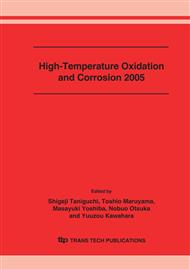p.111
p.119
p.129
p.139
p.147
p.155
p.163
p.171
p.181
Beneficial Effect of Impurity Sulfur on High-Temperature Steam Oxidation of High Chromium Ferritic Steels
Abstract:
The effect of S in steels on high-temperature steam oxidation resistance was investigated with respect to the content and the state in high Cr ferritic steels. The beneficial sulfur effect on high-temperature steam oxidation resistance was verified in high Cr ferritic steels. It was considered that Cr was enriched in the vicinity of the segregated S on the specimen surface because of a strong affinity between Cr and S atoms, resulting in the easy formation of the passive Cr2O3 oxide layer on the surface even after the steam oxidation test for a short time. It was found that the precipitated S operated more effectively to the improvement of the steam oxidation resistance compared to the solid-solution state of S in the steels. Furthermore, the sulfur effect on the high temperature steam oxidation resistance was related strongly to the amount of dissolution hydrogen in the high Cr ferritic steels.
Info:
Periodical:
Pages:
147-154
Citation:
Online since:
August 2006
Keywords:
Price:
Сopyright:
© 2006 Trans Tech Publications Ltd. All Rights Reserved
Share:
Citation:


